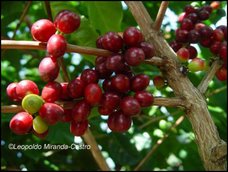
I wrote this article back in 2001! It was published back in 2001 in the US Fish and Wildlife News (
http://www.fws.gov/news/pdf/News_SP04.pdf) (Page 16). We'll need to update the number of acres etc. but It's still very current.
I'm not in Puerto Rico anymore but the number of acres of shade coffee plantations restored are WAY MORE! Thanks to the hard work of all the hard-working coffee producers, Non-profit Organizations, and the government agencies involved (both local and federal). But most of the credit should go to Mrs. Silmarie Padron which has been in charge of these efforts for the last 6-7 years!
(This little bird is the "Puerto Rican Tody". A species that can only be found in the Caribbean island of Puerto Rico. This bird is very common in shade-grown coffee plantations.)Here is the article:
Restoring Tropical Environments, or Is That Coffee Shade-Grown?
Is your coffee habit destroying tropical habitat? If you’re not drinking shade-grown coffee, then the answer is YES! Traditionally, coffee was cultivated under a shading canopy of native trees in tropical areas of the world. Modern coffee plantations are often monocultures grown in direct sunlight, creating conditions that cause increased stress on coffee plants. Their response to these conditions is to “reproduce before dying,” producing more coffee beans per plant, but only for five to seven years. The plants then rapidly drop their production of coffee beans, are increasingly vulnerable to insect and disease damage, and soon must be replaced. The remaining soils are nutrient poor and easily eroded. Within the U.S., coffee is commercially cultivated only in Hawaii and Puerto Rico.
Shade coffee plantations are a simple but stable agro-ecosystem that can be an important wildlife management tool. A shaded canopy provides most of the ecological functions of the natural environment, including soil conservation, nutrient recycling, habitat for native, endemic and migratory birds, and shelter for many plant and wildlife species. As an added bonus, recent studies have demonstrated that net yields and profits from shade coffee plantations are higher than modern cultivation methods. Of the approximately 90,000 acres of coffee grown in Puerto Rico, less than 40 percent is shaded by a canopy of native trees.
The Service’s Partners for Fish & Wildlife Program in the Caribbean is the only shade coffee restoration effort currently occurring within the U.S. Through this voluntary, private landowner-Service partnership, simple habitat restoration techniques were developed that allowed farmers to improve production, reduce the application of fertilizers and pesticides, and reduce labor costs. In addition, secondary crops, such as citrus fruit, bananas, plantains, coconuts, pineapples, cut flowers, and other products diversify the farmers’ products, making farming more sustainable way of life.
In its first four years, Partners for Fish and Wildlife has restored more than 1,000 acres through this innovative tropical habitat restoration partnership. Working with the Puerto Rico Department of Agriculture, Natural Resources Conservation Service, U.S. Forest Service, Agricultural Extension Service, and Organization Envirosurvey, Inc., has led to great success. Even local schools got involved – working with the Puerto Rico Department of Natural Resources, they provided more than 10,000 native legume trees. The primary benefit of the restoration was habitat enhancement for many Neotropical migratory birds, endemic birds, such as the Puerto Rican vireo, endangered Puerto Rican Sharp-shinned hawks (Accipiter striatus venator) and the Puerto Rican boa (Epicrates inornatus).
So next time you go in search of a Cup-AJoe, consider where those coffee beans came from and all the benefits of shade grown coffee—better yet, remember that the Service is making a difference by restoring tropical habitats. And make that next cup of coffee shade-grown!
**********************************************************************************
For more information go to
http://www.gooddogcoffee.com/Leo
 They expand and discuss that the results of this study are consistent with findings on 83,076 women in the Nurses Health Study in the USA in 2009. In that study, women who drank four or more cups of coffee a day had a 20% reduced risk of stroke, compared with women who had less than one cup per month. That study distinguished between caffeinated and decaf; the decaf group had a slightly lower risk.
They expand and discuss that the results of this study are consistent with findings on 83,076 women in the Nurses Health Study in the USA in 2009. In that study, women who drank four or more cups of coffee a day had a 20% reduced risk of stroke, compared with women who had less than one cup per month. That study distinguished between caffeinated and decaf; the decaf group had a slightly lower risk.







 Well, A few years ago I gave a presentation on this topic. Today, a co-worker asked me about it. Not the presentation, but about the possible effects of runoff from coffee plantations in Hawaii and
Well, A few years ago I gave a presentation on this topic. Today, a co-worker asked me about it. Not the presentation, but about the possible effects of runoff from coffee plantations in Hawaii and 




